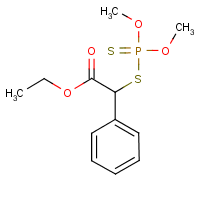Phenthoate
Agent Name
Phenthoate
CAS Number
2597-03-7
Formula
C12-H17-O4-P-S2
Major Category
Pesticides

Synonyms
(Dimethyl S-(phenylethoxycarbonylmethyl)phosphorothiolothionate); Acetic acid, (O,O-dimethyldithiophosphorylphenyl)-, ethyl ester; Acetic acid, mercaptophenyl-, ethyl ester, S-ester with O,O-dimethyl phosphorodithioate; BAY 33051; BAY 18510; Bayer 18510; Benzeneacetic acid, alpha-((dimethoxyphosphinothioyl)thio)-, ethyl ester; Cidemul; Cidial; Cidial ULV; Dimefenthoat; Dimephenthioate; Dimephenthoate; ENT 23,438; ENT 27386; ENT 27386GC; Elsan; Elsan ULV; Ethyl 2-dimethoxyphosphinothioylthio(phenyl)acetate; Ethyl 2-dimethoxythiophosphorylthio-2-phenylacetate; Ethyl O,O-dimethylphosphorodithioyl phenyl acetate; Ethyl O,O-dimethylphosphorodithioylphenylacetate; Ethyl alpha-((dimethoxyphosphenothioyl)thio)benzeneacetate; Ethyl ester of O,O-dimethyldithiophosphoryl alpha-phenyl acetate; Ethyl mercaptophenylacetate O,O-dimethyl phosphorodithioate; Ethyl mercaptophenylacetate S-ester with O,O-dimethyl phosphorodithioate (8CI); Ethyl mercaptophenylacetate-O,O-dimethylphosphorodithioate; Fenthoate; L-561; Montecatini L-561; O,O-Dimethyl S-(1-carboethoxybenzyl) dithiophosphate; O,O-Dimethyl S-(alpha-ethoxycarbonylbenzyl) thiophosphate; O,O-Dimethyl S-(phenyl)(carboethoxy)methyl phosphorodithioate; O,O-Dimethyl S-alpha-ethoxycarbonylbenzyl phosphorodithioate; O,O-Dimethyl-S-(alpha-(carboethoxy)benzyl)phosphorodithioate; O,O-Dimethyl-S-(phenylacetic acid ethyl ester) phosphorodithioate; OMS 1075; PAP; Papthion; Phendal; Phenthoate 50 EC; S 2940; S-alpha-Ethoxycarbonylbenzyl O,O-dimethyl phosphorodithioate; S-alpha-Ethoxycarbonylbenzyl dimethyl phosphorothiolothionate; TH 346-1; TH-346-I; Tagson; Tanone; Tsidial; [ChemIDplus]
Category
Organophosphate Insecticides
Description
Colorless solid; mp = 17-18 deg C; Technical product: reddish-yellow liquid; [HSDB] Liquid; [MSDSonline]
Sources/Uses
Used as insecticide and acaricide for rice, vegetables, fruits, and tea; [HSDB]
Comments
No evidence of mutagenicity; [HSDB] In 116 week feeding study with rats cholinesterase activity was depressed, but no significant histopathological findings or increased tumor frequency; [Reference #1] “The average of two baseline respective cholinesterase activity determinations three days apart, with no exposures to enzyme inhibiting pesticides for at least 30 days, is recommended for each worker prior to exposure to cholinesterase inhibitors because of large inter-individual differences in published baseline values. To be established at least once a year. Removal from workplace exposures is recommended until the cholinesterase activity returns to within 20% of baseline.” [TLVs and BEIs]
Restricted
Cancelled--no longer registered as a pesticide for use in the US; [HSDB]
Reference Link #1
Biomedical References
Exposure Assessment
BEI
Acetylcholinesterase activity in red blood cells = 70% of individual's baseline; Butylcholinesterase activity in serum or plasma = 60% of individual's baseline; Sample at end of shift; [TLVs and BEIs]
Vapor Pressure
2.6E-06 mm Hg
Lethal Concentration
LC50 (rat) = 59 mg/m3/4h
Adverse Effects
Other Poison
Organophosphate
Diseases, Processes, and Activities Linked to This Agent
Diseases
Occupational diseases associated with exposure to this agent:
Processes
Industrial Processes with risk of exposure: